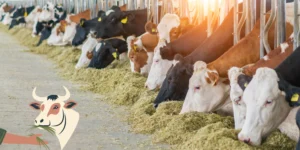
Preserving cow feed is essential to ensure that the animals have access to nutritious and safe food throughout the year. Proper feed preservation methods help prevent spoilage, nutrient loss, and contamination. Here are some common methods used to preserve cow feed:
1. Silage Preservation (Fermentation Process)
- What It Is: Silage is fermented, high-moisture feed made from grass, corn, or other forages that are stored in airtight conditions (like silos or plastic-wrapped bales).
- How It Works: The fermentation process, carried out by beneficial bacteria, preserves the feed and helps maintain its nutrients for later use. The high moisture content (around 60-70%) is critical for successful fermentation.
- Tips for Success:
- Ensure the feed is packed tightly in the silo or bale to remove as much air as possible.
- Monitor the pH levels to ensure proper fermentation.
- Use high-quality, clean feedstuff to start.
2. Hay Preservation
- What It Is: Hay is dried forage, often made from grasses like alfalfa, clover, or timothy, and stored in bales.
- How It Works: The drying process removes moisture (less than 15%) to prevent the growth of mold and bacteria. Once dried, hay is stored in a cool, dry area, protected from moisture and sunlight.
- Tips for Success:
- Dry hay quickly to prevent mold growth.
- Store hay in a dry, well-ventilated place to prevent moisture from re-entering.
- Protect hay from direct sunlight, which can degrade vitamins like Vitamin A
3. Haylage Preservation
- What It Is: Haylage is similar to silage but made from grass or legumes that are dried to a moisture content of around 40-60% before fermentation.
- How It Works: Haylage is stored in airtight conditions, like silos or wrapped bales, and undergoes fermentation, similar to silage but with less moisture.
- Tips for Success:
- Ensure proper moisture content to avoid molding.
- Store in well-sealed conditions to maintain quality and prevent spoilage.
4. Drying and Grinding (For Concentrates)
- What It Is: For grains like corn, soybeans, or oats, drying is crucial to preserve the feed and prevent mold and spoilage.
- How It Works: Drying the grains to a low moisture level and grinding them into smaller particles makes them easier for cows to digest. The dried grains are then stored in sealed containers or bins.
- Tips for Success:
- Use appropriate drying equipment (e.g., a grain dryer).
- Store the grains in a cool, dry place to avoid moisture absorption.

5. Freezing (For Green or Wet Feeds)
- What It Is: Freezing fresh green forage or wet feeds can help preserve their nutritional value for later feeding.
- How It Works: Freezing prevents the growth of bacteria and preserves the vitamins and nutrients in the forage.
- Tips for Success:
- Ensure that the feed is properly packed before freezing to avoid freezer burn or damage to the feed.
- Once thawed, feed immediately as some quality may be lost.
6. Use of Additives (Preservatives)
- What It Is: Some farmers use commercial preservatives or additives like organic acids (propionic acid or formic acid) or inoculants to preserve feed and prevent spoilage.
- How It Works: These additives help control microbial growth and maintain the nutritional content of the feed.
- Tips for Success:
- Use additives as directed to avoid overuse, which could affect the cows’ health.
- Make sure the preservatives used are safe and approved for animal consumption.
7. Fermented Feed or Grains (Wet or Liquid Feeds)
- What It Is: Wet feeds like fermented grains can be used to supplement dry feed, especially during colder months.
- How It Works: The fermentation process not only preserves the feed but also helps break down the starches and fibers in the grains, making them easier for cows to digest.
- Tips for Success:
- Monitor the moisture levels and fermentation temperature to avoid spoilage.
- Store the wet feed in airtight containers or silos.
8. Storage Considerations
- Dry, Cool Conditions: Always store preserved feeds in dry and cool conditions to prevent spoilage and preserve nutrients.
- Air-tight Containers: Use silos, plastic wraps, or sealed containers to prevent oxygen from affecting the feed and causing spoilage.
- Avoid Contamination: Ensure the feed storage areas are free from pests, mold, and dirt.
By applying these preservation methods, you can ensure a consistent, high-quality feed supply for your cows throughout the year. Would you like to know more details on any specific method or how to implement them?

